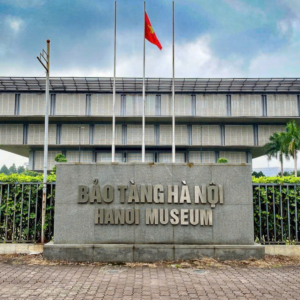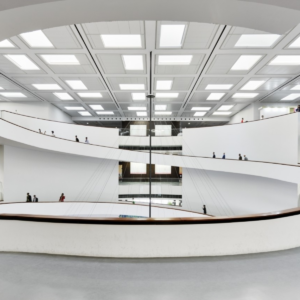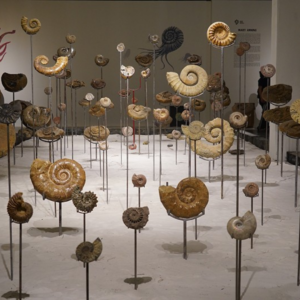Hanoi Museum – Discover the City’s Past in a Modern Upside-Down Pyramid
Hanoi Museum – A Captivating Journey Through Time
Deep in the bustling heart of Hanoi, there’s a place where the city’s past, present, and future come together. It’s called Hanoi Museum, a striking “upside-down pyramid” that invites you to explore the capital’s stories — from prehistoric times to the modern day. Whether you love history, architecture, or simply want a new perspective on Hanoi travel, this museum is an absolute must-visit.
>> Top Weekend Activities in Hanoi
About Hanoi Museum

Hanoi Museum is a modern cultural center located on Pham Hung Street in Hanoi. Built in an “upside-down pyramid” style, it showcases thousands of artifacts tracing the city’s journey from ancient times to the present day. Visitors can explore interactive exhibits about Hanoi’s history, culture, and daily life, all arranged across multiple floors connected by a wide spiral ramp. Opened in 2010 to mark the city’s 1000th anniversary, Hanoi Museum offers a unique window into the capital’s past, providing a calm and informative experience for everyone, from curious students to seasoned travelers.
The Museum’s Distinctive Architecture
– Upside-Down Pyramid Design
- Shape & Structure: Instead of a traditional pyramid rising from a wide base to a narrow top, the Hanoi Museum’s exterior appears reversed. Each floor is larger than the one below, creating a striking silhouette.
- Symbolic Meaning: This inverted form symbolizes the idea of “unearthing” history as you move upward — much like uncovering layers of Hanoi’s cultural past.
– Multi-Level Spatial Flow
- Four Main Floors: The museum spans four stories, each dedicated to different historical periods and cultural themes of the city.
- Central Ramp: A broad, gently sloping ramp spirals through the core, guiding visitors seamlessly from the ground floor to the upper levels. This design invites a continuous, uninterrupted exploration experience.
– Open-Plan Galleries & Natural Lighting
- Wide Exhibiting Areas: Open floor layouts provide flexible space for large artifacts, interactive displays, and specialized exhibits without feeling cramped.
- Glass Facades & Skylights: Natural light filters through glass walls and overhead skylights, reducing the need for harsh artificial lighting. It also creates an airy, inviting atmosphere.
– Harmonious Exterior Landscape
- Reflective Pond & Garden: Surrounding water features and green walkways offer a soothing environment for breaks or photo stops.
- Outdoor Installations: Occasionally, the museum hosts temporary art or cultural installations in its front courtyard, blending modern creativity with the museum’s architectural theme.
– Eco-Friendly & Modern Systems
- Ventilation & Cooling: The unique geometric design aids in airflow, while modern HVAC systems ensure comfort for visitors.
- Accessibility: Elevators, ramps, and wide corridors make the museum accessible for everyone, including parents with strollers and visitors with mobility challenges.
Exhibitions & Highlights
– Ancient & Feudal Hanoi
- Early Artifacts: Stone tools, pottery, and bronze drums offer a glimpse into the city’s prehistoric and dynastic periods.
- Royal Influence: Imperial seals, court garments, and traditional housing models reveal how Hanoi evolved under various Vietnamese dynasties.
– Colonial & Modern Times
- French Colonial Legacy: Photographs and documents from the late 19th and early 20th centuries demonstrate the mix of Vietnamese and French cultures.
- Independence & Revolution: Historic records and personal stories illustrate Hanoi’s role in Vietnam’s journey towards independence.
– Everyday Life & Cultural Traditions
- Folk Crafts & Festivals: Textiles, handicrafts, and festive costumes highlight the city’s colorful heritage.
- Lifestyle Exhibits: Recreated street scenes, old bicycles, and tools capture the rhythm of daily life in past decades.
– Rotating Special Exhibitions
- Themed Displays: The museum often hosts temporary shows focusing on specific topics like the Ao Dai (traditional dress), local festivals, or contemporary art.
- Seasonal Events: Celebrations and interactive programs for holidays like Tet or the Mid-Autumn Festival, where visitors can experience hands-on cultural activities.
– Interactive & Multimedia Sections
- Digital Presentations: Touch screens and audio guides provide deeper commentary in multiple languages.
- Models & Dioramas: Scaled re-creations of old Hanoi neighborhoods or architectural landmarks make history come alive for younger audiences.

How to Visit & Practical Tips
– Location & Access
- Address: Pham Hung Street, Nam Tu Liem District, near the National Convention Center
- Transport: Easily reached by bus (routes #33, #39, #50), taxi, or Grab from central Hanoi (about 7–10 km away)
– Opening Hours & Fees
- Hours: 8:00 AM – 5:00 PM, Tuesday to Sunday (closed Mondays)
- Admission: Often free or at a very modest charge (check notices at the ticket counter)
– Best Time to Visit
- Weekday mornings or early afternoons for fewer crowds
- Avoid peak weekends or public holidays if possible
– On-Site Amenities
- Guide services: English brochures, occasional guided tours, helpful staff
- Facilities: Café or small refreshment stands (availability may vary), rest areas, clean restrooms
- Photo-ops: Scenic gardens and reflective ponds around the museum’s “upside-down pyramid” structure
Nearby Attractions (Detailed Location)
- National Convention Center
- Distance from Hanoi Museum: ~300 meters (a 5-minute walk)
- What to See: Impressive modern architecture, government events, and conferences.
- Getting There: Simply walk straight from the museum’s main exit; the Convention Center is clearly visible across the avenue.
- Keangnam Landmark 72
- Distance: ~2.3 km (7–10 minutes by taxi or Grab)
- What to See: Hanoi’s tallest building complex, with an observation deck for panoramic city views, plus shopping and restaurants.
- Getting There: Head south along Pham Hung Street; follow signposts or use a ride-hailing app for convenience.
- The Garden Shopping Center
- Distance: ~2 km (7 minutes by car)
- What to See: Modern mall featuring international brands, a food court, and occasional events or promotions.
- Getting There: A short ride by taxi or Grab along Me Tri or Pham Hung Street; local bus routes also pass nearby.
- My Dinh National Stadium
- Distance: ~3.5 km (10 minutes by taxi or Grab)
- What to See: Vietnam’s largest stadium, hosting football matches, concerts, and sports events.
- Getting There: Take Le Quang Dao Street from Me Tri intersection; stadium signage is clear, and you can also follow digital maps.
- Hanoi Museum Walkways & Green Spaces
- Distance: Right outside the museum’s perimeter (0–200 meters)
- What to See: Beautiful landscapes, small ponds, and manicured gardens offering a calm retreat after your museum visit.
- Getting There: Step out from the museum’s exit, then turn left toward the landscaping paths surrounding the building.

Conclusion
Hanoi Museum is more than just a building of exhibits – it’s a living portrait of the city’s soul, capturing its many layers of history, daily life, and cultural evolution. Whether you’re a local or a visitor, walking through its spiral paths and exploring each gallery offers a unique way to understand Hanoi’s vibrant past and ever-changing present.
Curious about Hanoi’s hidden stories and heritage? Make sure to add Hanoi Museum to your travel list and experience the city’s journey through time under one striking roof. Let VNITourist guide you to the best cultural gems in Vietnam.

